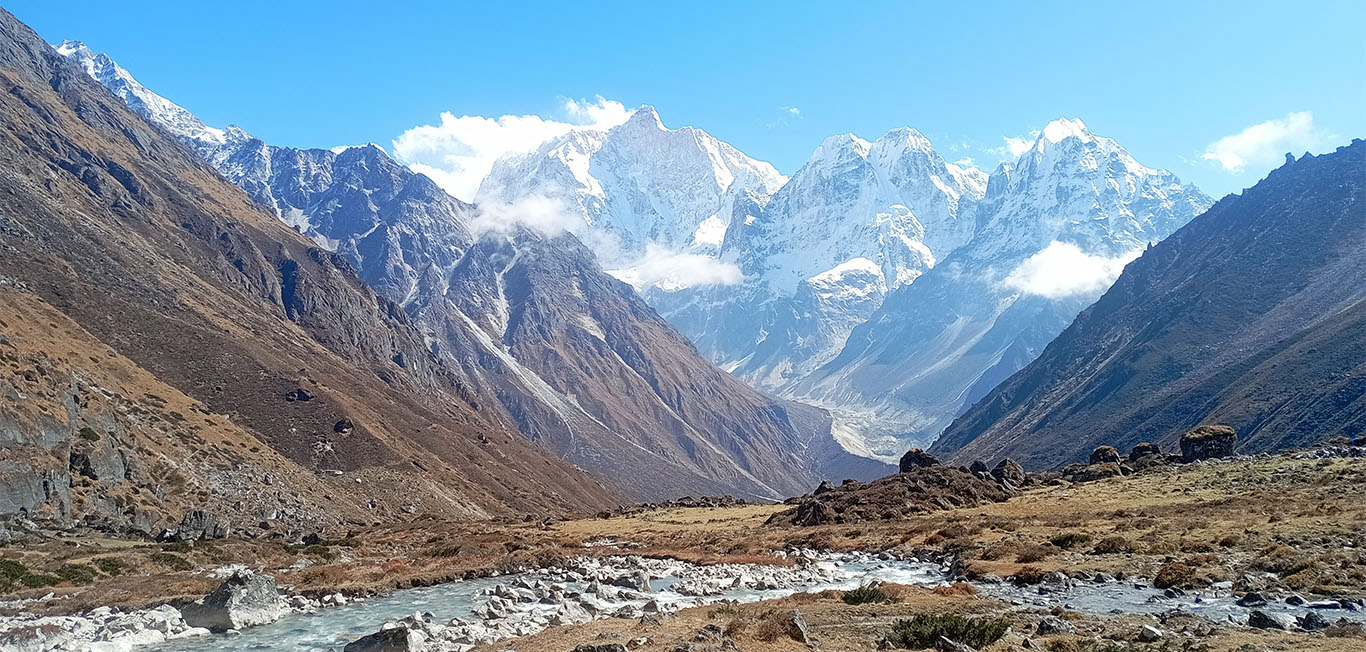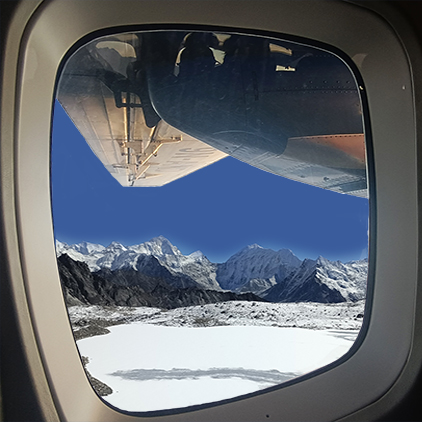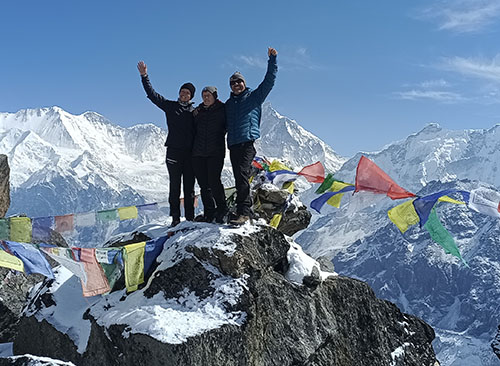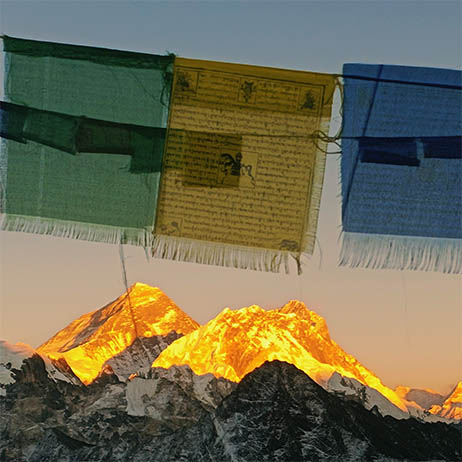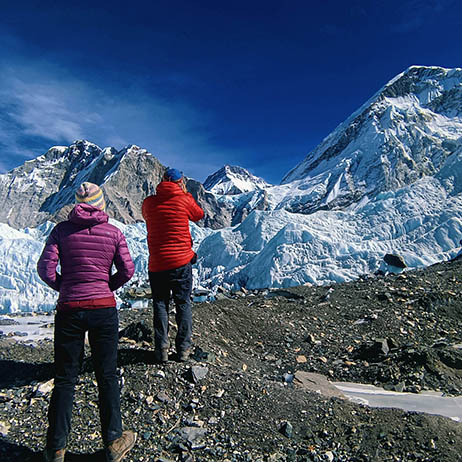One of the most spectacular and exciting trekking routes in Nepal, the Kanchenjunga Circuit Trek offers a remote trekking experience in the far eastern Himalayas. The incredible trek circumnavigates the base of Mount Kanchenjunga, the third-highest mountain in the world at 8,586 meters. "Five Treasures of the Great Snow" is the name for Kanchenjunga, and it is not just revered for its height but also for its sacred significance. The five peaks of the mountain, according to local legends, represent treasures of gold, silver, jewels, grain, and sacred scriptures.
What truly distinguishes the Kanchenjunga Circuit Trek is its geographical and cultural location. The region lies at the crossroads of three international borders: Nepal, India (Sikkim), and Tibet (China). Few treks on earth can claim such a strategic location, giving a heightened sense of remoteness and adventure. The landscape here is pristine, and the trails are far less frequented, so for adventurers seeking an authentic off-the-beaten-track Himalayan experience, it's a dream destination.
The trek traverses Kanchenjunga National Park, which is home to a breathtaking variety of flora and fauna, from blue sheep and red pandas to rhododendron forests and enormous alpine meadows. Culturally, you'll trek through Limbu, Rai, and Sherpa villages that maintain ancient cultures, traditions, and languages. Unlike commercialized trekking zones, Kanchenjunga is untouched and authentic, where time remains still and the mountains speak in silence.
The full circuit typically involves a trip to both the Kanchenjunga North and South Base Camps, allowing trekkers to witness Kanchenjunga's beauty from diverse angles. Massive glaciers, high mountain passes, sacred lakes, and magnificent ridgelines make every day of the trek visually and spiritually rewarding. Due to its remoteness, there are fewer trekkers visiting, which is both a challenge and a boon. You'll need special permits, a licensed guide, and sound logistical arrangements, but what you gain is a lifetime trek into the wild heart of the Himalayas. With Visit Himalaya Treks, you'll experience this breathtaking area with veteran guidance, cultural insight, and ease in an otherwise rough landscape.
The Kanchenjunga Circuit Trek is more than a path; it's a journey through three cultures, a hike through a sacred landscape, and a spiritual pilgrimage in the shadow of snow giants.
Where is the Kanchenjunga Circuit Trek Located?
The Kanchenjunga Circuit Trek is located in the far north-east region of Nepal, in the Taplejung District, closely connected to the borders with Sikkim (India) and Tibet (China). The trek lies inside the Kanchenjunga Conservation Area (KCA), a protected area renowned for its pristine high-altitude alpine ecosystems, unique biodiversity, and inaccessible high-altitude settlements.
The trek generally begins with a flight from Kathmandu to Bhadrapur (or Suketar at the peak time of year) and then a scenic drive through tea gardens and rolling hills to the trailhead. The hike circumambulates Mount Kanchenjunga, both Kanchenjunga South Base Camp (Ramche) and Kanchenjunga North Base Camp (Pang Pema), connected by high-altitude passes and remote Sherpa villages.
Because it lies at the border of three countries, Tibet, Nepal, and India, the Kanchenjunga region is not only physically stunning but also politically significant and culturally rich. It's one of the few treks in Nepal where you can feel the heritage of three Himalayan cultures blending together into a single holy landscape.
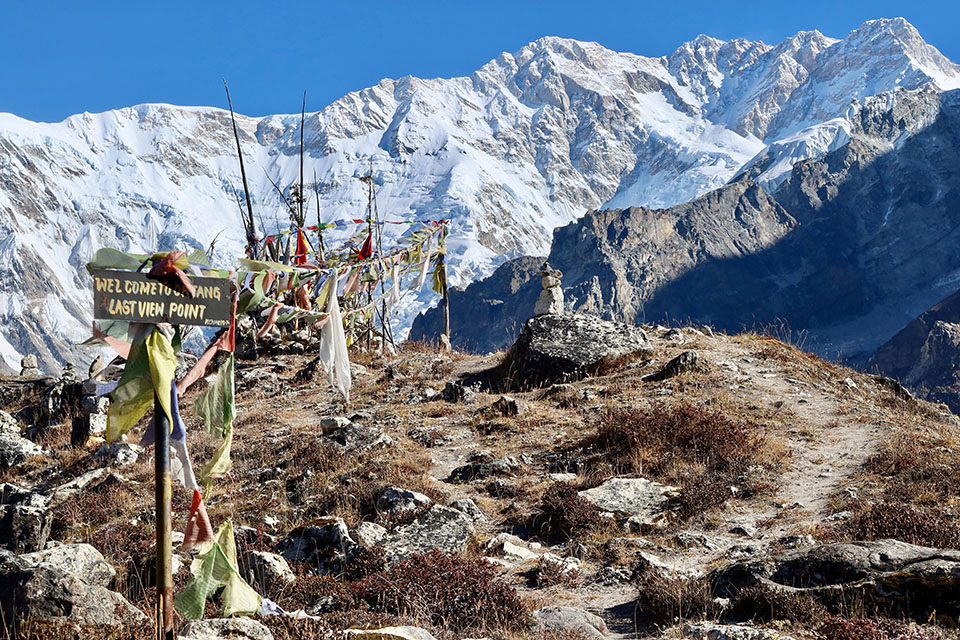
The view of the Kanchenjunga South Massif from Oktang View Point while trekking the Kanchenjunga Circuit.
Highlights of the Kanchenjunga Circuit Trek:
- Witness the world's third-tallest mountain, Mount Kanchenjunga (8,586m), a sacred mountain at the junction of Nepal, Tibet, and India.
- Trek to both Pang Pema (North Base Camp) and Ramche (South Base Camp) on one itinerary, a rare opportunity.
- Enjoy a peaceful and remote trekking trail with far fewer trekkers than Everest or Annapurna.
- Encounter Limbu, Rai, Sherpa, and Tibetan communities with their distinct traditions, languages, and religious beliefs.
- Walk through green valleys, rhododendron forests, alpine meadows, and glacial moraines at high elevation.
- Spot elusive creatures like snow leopards, red pandas, Himalayan black bears, and pheasants within the Kanchenjunga Conservation Area.
- Ideal for experienced trekkers looking for a demanding itinerary that offers solitude, adventure, and panoramic mountain views.
- Cross high passes like Sele La and Sinion La, with stunning Himalayan vistas and challenging trails.
- Explore centuries-old gompas, mani walls, and sacred caves reflecting Tibetan Buddhist and Bon culture.
- Journey through an untouched conservation zone with responsible tourism and community livelihood.
Best Time to Trek the Kanchenjunga Circuit:
The Kanchenjunga Circuit Trek is a trail that leads you through some of Nepal's most remote and diverse landscapes, dense forests, high-altitude glacial basins, and everything in between. Given the long trekking duration, great elevation, and unsteady ground, choosing the right time of year to trek is crucial to safety, comfort, and enjoyment. The best season for the Kanchenjunga Circuit Trek is pre-monsoon (spring) and post-monsoon (autumn) when the weather is more stable, skies are clear, and trails are in good shape.
Autumn Season (Mid-September to Early December)
Autumn is the best time to trek the Kanchenjunga region. After the summer monsoon has cleared the air, you’re greeted with crisp mountain views, mild daytime temperatures, and dry trails. The skies are generally cloud-free, offering uninterrupted views of the Kanchenjunga massif, Jannu Himal, and surrounding peaks. The vegetation is still lush and green from the monsoon rains, adding to the beauty of the lower sections of the trail. Local festivals such as Dashain and Tihar also occur during this time, giving trekkers the experience of Nepali culture at its best.
Spring Season (March to Mid-May)
The spring season is also a good time to trek the Kanchenjunga Circuit. The weather begins to warm up from the cold winter, so trekking at high altitudes is more comfortable. Most of all, it's the season when rhododendrons are in full bloom and paint red, pink, and white patches on the forests. These days guarantee fine mornings with pleasant temperatures and clear weather that make photographers and nature lovers prefer such a season. The activity of wildlife also rises during these times and presents greater opportunities for sighting Himalayan species.
Can You Trek in Winter or Summer?
December to February winter trekking is possible but not recommended unless you are a highly experienced high-altitude trekker. Snow in the higher passes, like Sele La, and chances of avalanches can make the trek unsafe and logistically difficult. June to August is monsoon season in Nepal, and the trails are mushy, slippery, and prone to landslides. Visibility is typically poor, and there are leeches in forests at lower altitudes. However, the rain shadow phenomenon in parts of eastern Nepal means that some parts of Upper Kanchenjunga are able to be crossed cautiously and with planning.

Group picture at Sinion La Pass (4646m) trek, from Kanchenjunga South to North, with Rathong and Kabru in the background.
Trekking Trails and Itinerary Choices:
The Kanchenjunga Circuit Trek is among the most remote and scenic long-distance trekking routes of Nepal. The trek leads you to both the Kanchenjunga North Base Camp (Pangpema) and the South Base Camp (Ramche), offering you an adventurous loop across alpine valleys, glacier-fed streams, yak grazing pastures, and typical Rai, Limbu, and Sherpa villages.
The following is a proposed 21-day itinerary covering both North and South Base Camps.
Day 01: Arrive at Kathmandu, receive at the Airport, and transfer to the Hotel.
Day 02: Trek and Kanchenjunga Special Permits Preparation.
Day 03: Flight to Bhadrapur and drive to Taplejung, 1820 meters.
Day 04: Drive to Ranipul 1740 meters, Trek to Lamatar 1600 meters.
Day 05: Trek to Thangyam (Thyanyani) 2500 meters.
Day 06: Trek Ghunsa (3595 meters)
Day 07: Acclimatization Day at Ghunsa 3595 meters.
Day 08: Trek to Khangpachen (Khambachen) 4050 meters.
Day 09: Acclimatization day at Khangpachen (Khambachen) 4050 meters.
Day 10: Trek to Lhonak (4780 meters)
Day 11: Side trip to Pangpema Kanchenjunga North Base Camp (5143 meters)
Day 12: Trek back to Ghunsa village.
Day 13: Trek to Sele La (4290 meters)
Day 14: Trek to Cheram (Tseram ) 3870 meters.
Day 15: Trek to Ramche (4580 meters)
Day 16: Trek to Cheram (Tseram) 3870 meters.
Day 17: Trek to Tortong (2995 meters)
Day 18: Trek to Sherpaguan / Yamphuding (2080 meters)
Day 19: Drive to Kanyam and stay overnight at Kanyam, 1368 meters.
Day 20: Drive to Bhadrapur and flight to Kathmandu.
Day 21: Departure. Transfer to the airport for departure.
Permits and Access Rules to Kanchenjunga Circuit Trek;
The Kanchenjunga Circuit Trek will lead you to one of the most isolated and sensitive trekking regions in Nepal, bordering Tibet (China) and India. Because of its sensitive location and to safeguard its unspoiled natural environment and culture, the Government of Nepal requires a number of permits and rigid access rules for trekkers.
1. Restricted Area Permit (RAP)
The Kanchenjunga region is included in Nepal's restricted trekking regions. Trekkers must obtain a Restricted Area Permit from a registered trekking company.
Cost:
- USD 20 per person per week (for the first 4 weeks)
- USD 25 per person per week (after 4 weeks)
Requirements:
- Two people minimum trekkers per group
- Must be guided by a licensed trekking guide
- This permit is used to manage and regulate tourism in sensitive border regions.
2. Kanchenjunga Conservation Area Permit (KCAP)
Issued by the National Trust for Nature Conservation (NTNC), this permit supports funding for conservation and development of the local community within the region.
- Cost: NPR 2,000 per individual (approximately USD 15–17).
- Validity: For the entire extent of the trekking period within the Kanchenjunga Conservation Area.
3. Trekking Information Management System (TIMS) Card
Though TIMS cards are compulsory for most treks in Nepal, they are not required for restricted-area treks like Kanchenjunga, where the RAP is procured.
4. Obtaining Permits:
All the permits must be reserved in advance by a government-recognized trekking agency, like Visit Himalaya Treks. Solo trekking is not allowed, and the permits cannot be obtained by individual travelers.
5. Passport and Visa Requirements:
You must also have a valid Nepal tourist visa, which can be obtained:
Upon arrival at Tribhuvan International Airport (Kathmandu)
Or from a Nepali embassy or consulate abroad
Visa Fees:
- 15 Days – USD 30
- 30 Days – USD 50
- 90 Days – USD 125
The trekkers tend to opt for the much more convenient 30-day visa for the Kanchenjunga Circuit Trek.

Trek to the Kanchenjunga North Base Camp, where you’ll be greeted with breathtaking views of Kanchenjunga North.
Kanchenjunga Circuit Trek Summary;
Kanchenjunga Circuit Trek offers a one-time journey into the world's most remote and untouched Himalayan corner, where natural beauty, rich biological diversity, and strong local culture meet. Trekking in the Kanchenjunga Conservation Area not only enables travelers to experience breathtaking mountain landscapes but also to benefit from the outstanding fauna and flora density that characterizes the region. The meeting of three countries: Nepal, Tibet, and India, lends a distinctive geographical and cultural flavor to the trek, layering complexity to the experience.
For anyone who is a passionate naturalist, a culture explorer, or a committed trekker, the Kanchenjunga Circuit promises an experience that is out of the ordinary, marked by peace, discovery, and profound connection with the magnificent Himalayan scene. With proper preparation and respect for local regulations and conservation efforts, the trek remains a rewarding and realistic way of experiencing the "Five Treasures of the Great Snow."

